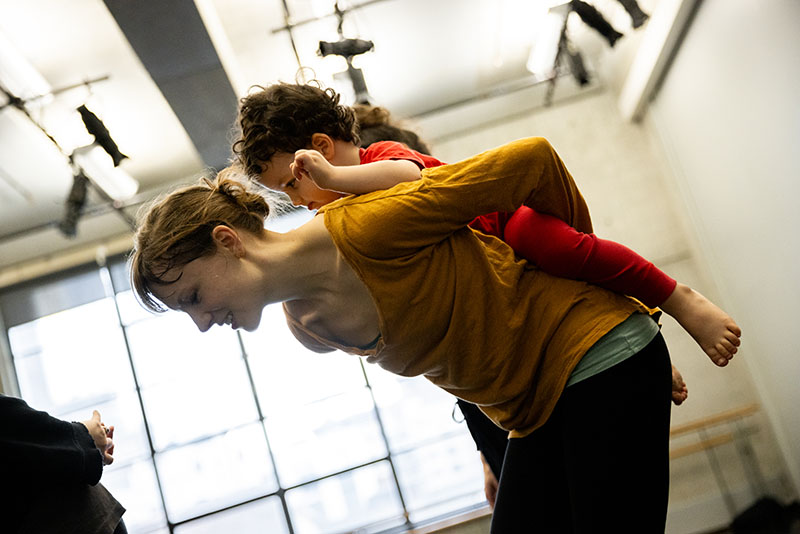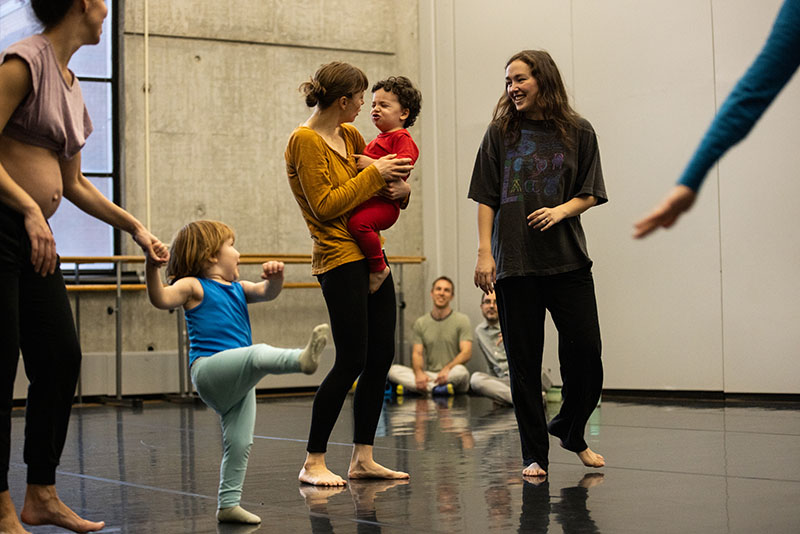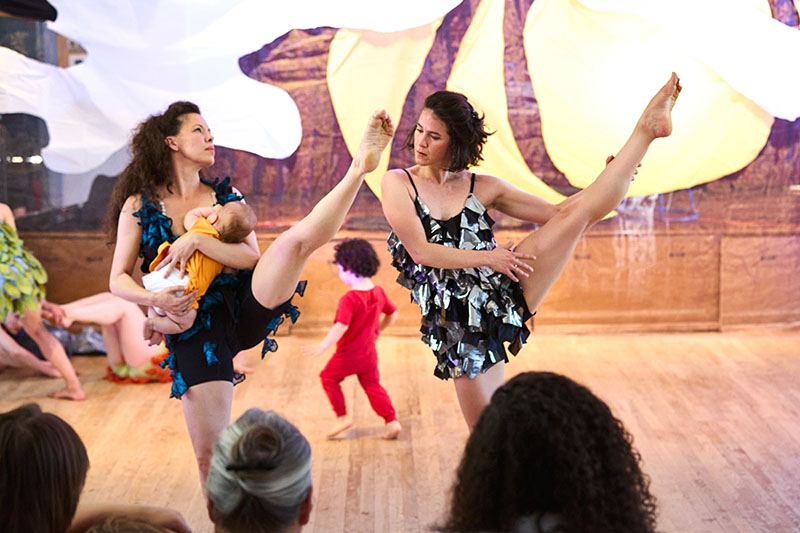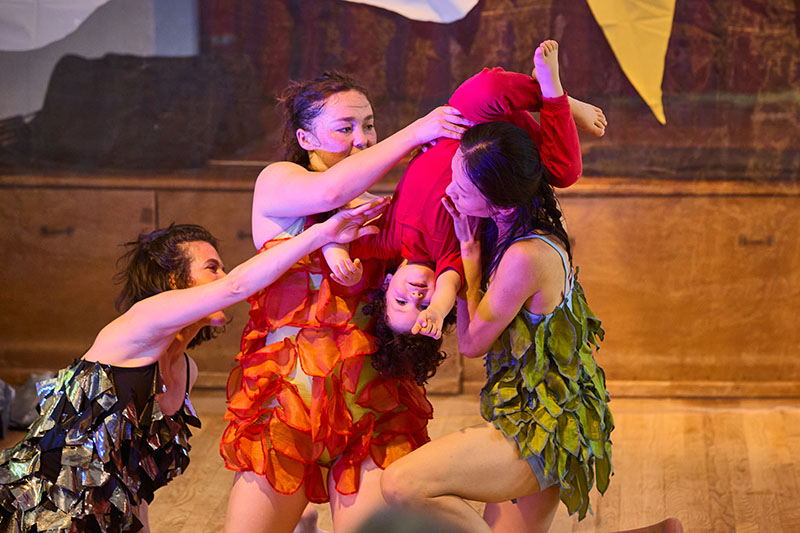Putting Parenting Onstage
October 27, 2025
An Interview with Esmé Boyce
BY EMMALY WIEDERHOLT
Esmé Boyce is a dance artist based in New York City. Her recent piece, The Humbling or Chapter of Mama: Part 1, premiered in 2023 and featured her toddler son and husband, the toddler, infant, and husband of dancer Caroline Fermin, as well as three other dancers. The piece aimed to be a critical reflection of the joys and challenges of being a mother and working artist. Here, Esmé reflects on her desire to have the labor of motherhood witnessed, how she integrated toddlers into the choreography while giving them space to have agency, and how she is reimagining the stage as a place to allow for parenting and caretaking.
Note: This article was published in Stance on Dance’s Fall/Winter 2025 print issue. To learn more, visit stanceondance.com/print-publication.

Photo by Maria Baranova
~~
What shaped you as an artist?
My dance education started with creative movement and improvisation which is still the foundation of my creative process today. As a kid and teenager, I fell deeply into a world of ballet and modern and later postmodern dance which shaped my movement vocabulary. In Chicago, I attended Second City Ballet and later the Ruth Page Foundation. When my family moved to Los Angeles I was fortunate to study with Meredith Baylis who was a wise, funny, holistic teacher and chosen family member. She instilled foundational values in me, encouraging me to be honest in my body and bring a rich imagination to the artform. In search of more training, I followed my friend and mentor Amelia to summer intensives at Ballet Met, Alonzo King’s LINES Ballet, The Martha Graham School, and the San Francisco Conservatory of Dance. As a junior and senior in high school, I studied privately with Julie Shulman and Glenn Edgerton. I attended The Juilliard School where I received a rigorous dance education and a BFA. After many years of dancing and choreographing professionally I attended graduate school at the University of Wisconsin-Milwaukee where I melded academic interest with dancemaking and earned an MFA.
However, it was my informal education that I received from my family that most strongly influenced how I think and my aesthetic point of view. My parents are both visual artists and my brother is a multidisciplinary artist and composer. As a child, I attended art openings, experimental films, museums, and new music concerts. It was these interdisciplinary experiences that expanded my imagination and led me towards a desire to invent worlds on stage.
How would you describe your dance practice prior to having your child and now?
Before I had my son, my life was saturated with dance. I had Tahlo during the pandemic, and suddenly that whole part of my life and how I identified as a person was turned upside down. I absolutely love motherhood, and also, performance was an important part of how I engaged with the world. In contrast, motherhood was private; I felt like a vessel for my son and had disappeared as my own person. I was so focused on his wellbeing that I found it challenging to rebuild the art life I had before.
It took time and some kind, gentle reintroductions but now I have found a balance and I value the time I spend dancing and choreographing as an integral part of feeling like myself. I include my son in as much of my art life as I can and I also teach creative movement at his school to bring what I have to offer into our child-rearing community. The reframing that comes with matrescence has helped me enjoy performing more than I ever did before. My child is now the most important thing in my life and that relief of pressure has made me a more grounded performer.
What was the impetus for your piece, The Humbling or Chapter of Mama: Part 1?
The Humbling came from trying to knit my life as an artist, performer, and choreographer with my life as a mother. I needed to bring those two worlds together. The conceptual visual artist Mierle Laderman Ukeles developed the idea of Maintenance Art when she was a new mother in the late 1960s. Her early work under this framework showed her time as a laundry folder and diaper changer and lunch maker, all the tasks involved in caretaking as art. Reframing what could be included as “art” appealed to me: I could invent a world that accommodated my artistic ideas and mothering.
I come from a postmodern lineage, so chaos as a choreographic element appealed to me. I decided I would make a piece where my child was the element of chaos. I wanted to be with him and also make a dance about this time in my life. I’d seen pregnant people on stage but had never seen the experience of parenting onstage. I knew so many creative parents who were experiencing what I was experiencing, and I wanted to force others to witness this intense, profound, love-filled experience of raising tiny people.

Photo by Maria Baranova
How did the piece develop?
I was lucky to have an open residency at Baryshnikov Arts in late October and early November 2023. That intensive, focused creation period was an absolute gift. They embraced the experimental aspect and took a risk. My idea was that my son would be in the space, my husband would be caretaking, and they would coexist with the dance. The piece would be flexible with a score-like quality. As the piece developed, my son wanted to be a participant. He learned the dance and would move in and out of it. The dance became the game.
During the making, dancer Caroline Fermin was pregnant with her second child. It was heart-opening and new to see her caring for her first child while pregnant and dancing full out. The group care was focused on her. It was gorgeous to witness the virtuosic strength and determination she embodied. There was a moment in the final showing where Caroline’s child wanted to be held. It was during her solo, and she was quite pregnant. She ended up carrying her child while dancing. Everybody was partnering and supporting her as she danced; it was so beautiful.
In the final performances, Caroline’s second child was three months old, and she wore her in a baby carrier. Again, Caroline had a moment in which her child was hungry right when she was dancing a duet. Caroline seamlessly nursed her baby while dancing fully with the support of her partner. For me these moments which emerged organically were the emotional and conceptual thesis of the work. I’m grateful to the whole cast for saying “yes” to this wild art adventure. It has been a way of honoring the fleeting beauty of this formative stage of life.
Having children in the space where dance was happening transformed the kids involved. It also brought out a refreshing, playful quality in the dancers. So many wonderful moments came out of us all playing. We had set material that we were not precious about, and we also let the piece breathe and have a life of its own each time we did it.
In addition to inviting children to be themselves onstage, the piece was designed for parents in the audience to bring their chaos as well. If a child in the audience had a meltdown, that was part of the piece; they didn’t have to leave and miss out on the art. I wanted to highlight that parenting is hard, and we want to do it, we just need a lot of understanding and support. For example, the show couldn’t be at 7:30 or 8 p.m., so it was at 12 p.m. and 5 p.m. Something that simple is a game changer for a parent.
In the showing at the end of our residency, my son fell at the beginning. He started crying and couldn’t stop. He wasn’t injured, but he was embarrassed. I said, “You know what, we’re going to stop. I’m going to comfort my son, you all are going to wait and when we’re ready, we’re going to start again.” It was a vulnerable moment in which my mothering became the content and my instinct to perform fell to the wayside. When he was ready, he rejoined the dance.
The piece premiered at Arts on Site. I’m thankful to Amber Sloan for programming me. We received an amazing Bronx Cultural Visions Fund grant from Bronx Council of the Arts that supported the making and performances of the work. Having the support of my dance community was transformative and I felt more space was carved out for artist parents and caretakers of all kinds. Additionally, we presented the piece at my son’s preschool where we transformed the gym into a performance venue, facilitating bringing experimental art to audiences of parents, caregivers, and children from our neighborhood.

Photo by Jaqi Medlock
How old was your son during this process?
He was two and a few months when we began the piece; Caroline’s son was also two. We felt like we had to catch them where they were, as the piece was designed for that developmental stage. It was a way of honoring a specific time when they were beginning to no longer be babies. They were solid toddlers with lots to say.
Was the piece intended for children audiences, or for adults?
I made this piece for everyone, but specifically for parents. Once you think about what a parent might need, it includes many other needs as well. The piece was coming from my point of view. I had a hard time post-partum. I needed a witness of the experience. I also wanted to use the stage to create the world I want to see where caretaking and flexibility are important. It was a dance for adults. But at the same time, because there were children on stage and so much playfulness, it welcomed children. It allowed for multiple meanings to coexist.
What has The Humbling or Chapter of Mama: Part 1 taught you?
I think it’s shown me that art can be more flexible. I experience that flexibility in other people’s work as well. I dance for choreographer Megan Williams. She’s also a mother, though her children are grown, and she remembers what it was like to try to be a dance artist and a mother. She has made it so I can dance in her work, and if I’m running late or can’t remember complex steps because of being a parent, there’s understanding and flexibility and I still feel valued for what I do bring to the table.
I believe dance performance should be for putting human experiences on display and witnessing them; that exchange is fundamental. I want to see into other people’s worlds and have them see into mine. I want that shared give and take that dance allows. There should be a full breadth of experiences represented on stage. Raising children is often isolating, but it can be a communal activity. It also taught me that the world can be more malleable, compassionate, and supportive. A few perspective shifts go a long way in facilitating a full, inclusive life.
Do you have other iterations of the piece in mind as your child grows?
I am considering a Part 2. In Part 1, the audience was almost entirely friends, family, and people I knew from the dance community. It was a very warm and loving audience. The relationship between performer and audience gets complicated as my son gets older. The next iteration wouldn’t be for a public audience. I want to give the children and the artists that magical exchange, but the witnessing of what we make would be an informal setting of close friends and family, so the children feel safe and don’t feel pressure to perform if they don’t want to. I would leave ample room for agency while still fostering the artistic exchange that was so impactful.

Photo by Jaqi Medlock
~~
To learn more about Esmé’s work, visit www.esmeboycedance.com.

Responses
There are no comments at this time.
Be the first to start the discussion by filling out the comment form.